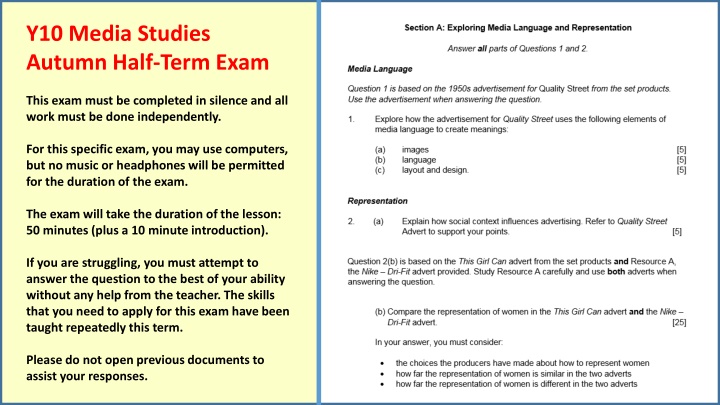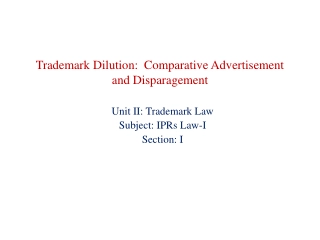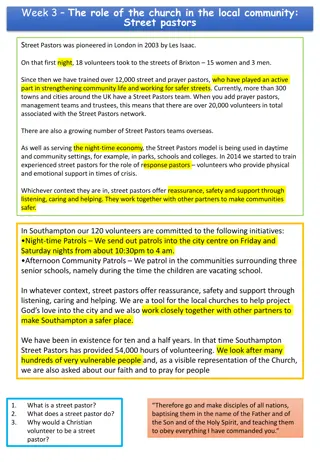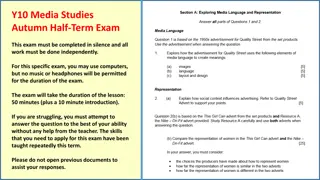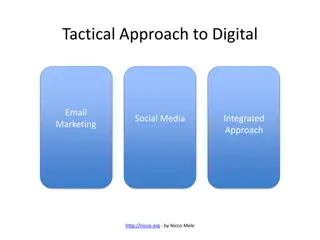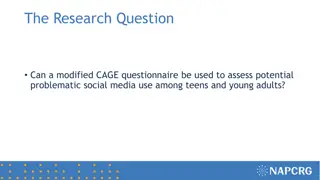Analysis of Quality Street Advertisement: Media Language and Social Context
The examination of a Quality Street advertisement highlights how media language and social context are utilized to create meanings. Analysis includes the portrayal of characters, use of language, and layout design. The influence of the 1950s patriarchal society on advertising is discussed, showcasing the evolving societal perspectives.
Download Presentation

Please find below an Image/Link to download the presentation.
The content on the website is provided AS IS for your information and personal use only. It may not be sold, licensed, or shared on other websites without obtaining consent from the author.If you encounter any issues during the download, it is possible that the publisher has removed the file from their server.
You are allowed to download the files provided on this website for personal or commercial use, subject to the condition that they are used lawfully. All files are the property of their respective owners.
The content on the website is provided AS IS for your information and personal use only. It may not be sold, licensed, or shared on other websites without obtaining consent from the author.
E N D
Presentation Transcript
Y10 Media Studies Autumn Half-Term Exam This exam must be completed in silence and all work must be done independently. For this specific exam, you may use computers, but no music or headphones will be permitted for the duration of the exam. The exam will take the duration of the lesson: 50 minutes (plus a 10 minute introduction). If you are struggling, you must attempt to answer the question to the best of your ability without any help from the teacher. The skills that you need to apply for this exam have been taught repeatedly this term. Please do not open previous documents to assist your responses.
Media Language EXAMPLE ANSWER #P1 1. Explore how the advertisement for Quality Street uses the following elements of media language to create meanings: Two women are kissing the cheek of a man wearing a suit who is holding sweets whilst the women take the sweet. This shows that the man is interested being a player and the two women are flirting with the man in order to get sweets. Images (5) There is an oval framed painting with a gold frame around it featuring Miss Sweetly and Major Quality looking at the three people playing on the sofa below. The gold frame acts almost like a halo, suggesting that there is an angelic quality to consuming Quality Street sweets. Sweetly and Quality s smiles suggests that they approve of the flirtation and mischief. The two alliterations delicious dilemma and delightfully different feature in the bottom right of the print advert. This shows that marketing techniques include the use of emotive language and catchy alliterations in order to grab the reader s attention. Language (5) The brand logo Quality Street (in a stylish purple typeface) has the surname Mackintosh s (a black cursive typeface) above it. This suggests that the brand were made by and is owned by the Mackintosh family. The fact that this writing is larger than the alliterative phrases emphasises its importance. The advert has been formatted with three specific sweet types in the bottom left, the advertising in the bottom right and the image taking up most space above. This shows that a structured and organised design appeals to a middle and upper class audience. The organisation of the advert differs from Layout and design (5) The suited and booted man is central in the frame. Even his positioning prioritises his importance. This reinforces his role as the dominant alpha male in charge stereotype. The patriarchal context of the era is even reflected in the layout of the poster.
EXAMPLE ANSWER #P2 Representation 2 (a). Explain how social context influences advertising. Refer to Quality Street Advert to support your points. Context is crucial in order to establish deeper meaning. Context can change the meaning of a text. The fact that this poster was made in the 1950s is significant. If this print advert featured in the London Underground in 2017, there would be serious complaints. However, the culture in the 1950s was highly patriarchal. It is clear that this era of sexism was considered normal (where women play the submissive role to men), but now it is starting to be challenged by more diverse representations. Social Context (5) There is a contrast in the clothing of Miss Sweetly/Major Quality and the two women and man on the sofa. This suggests that they are from different eras. Sweetly and Quality are actually mascots for the brand and have been for over 20 years (1930s) when this print advert came out. The advert wants to reinforce how times are changing and that a playboy lifestyle is now encouraged for young bachelor men. This was also the era of rock n roll music and popular rebellion was established during this time. Despite sexist notions, this poster also features liberal philosophy, particularly the freedom of young people to enjoy life to the fullest.
Question 2 (B) is based on the This Girl Can advert from the set products and Resource A, the Nike Dri-Fit advert provided. Study Resource A carefully and use both adverts when answering the question. Representation (b) Compare the representation of women in the This Girl Can advert and the Nike Dri-Fit advert. (25) In your answer, you must consider: - The choices the producers have made about how to represent women - How far the representation of women is similar in the two adverts - How far the representation of women is different in the two adverts. Resource A
EXAMPLE ANSWER #P3 This Girl Can Nike Dri-Fit This Girl Can features a sweaty woman in loose gym clothing with a smile on her face. The tagline for the print advert declares Sweating like a pig, feeling like a fox . This statement is a subversion of the insult that suggests that women sweating during exercise is unattractive. It has misogynistic connotations and increases self- consciousness for women who are not elite athletes. The advert intends to include everyone in exercise, regardless of their level of fitness. By subverting the insult, it takes the sting out of the stigma one can feel attractive whilst sweating, but exercise is healthy. The Nike Dri-Fit print advert features an athletic mixed-race woman in a running pose. She is wearing fashion label sportswear and is not sweating at all. The slogan is Move More, Move Better , which is written in italics reflecting the wind-resistance when athletes run. There is a Nike logo in the top right and the background is a blue skyline with a few skyscrapers suggesting that she is in a city. Nike is promoting an elite athlete who excels at sports and does not sweat at all while running. This advert has aspirational connotations for consumers who want to be elite runners. Sports labels tend to present athletes that the consumer desires to be like. A similar product is a Dri-Fit is Fitbit which acts as an exercising monitor. Key denotations and their connotations The producer has chosen to positively represent a woman who is not athletic and that she should not be ashamed of her current fitness level. Sports are male dominated and an exclusive culture has been typical of most sports, where elite athletes are prioritised over the everyday sports participator. The This Girl Can campaign is a feminist movement seeking to promote sport to all women, including everyone and rebuking the shame and stigma attached to sweating as ugly. The producer of the advert has chosen to only represent elite female athletes. The fact that no men feature in the advert shows that the advert celebrates feminine sporting excellence, but it does implicitly present an exclusive attitude where elite athletes are praised and average athletes are ignored. Choices producer made in the representation of women Both adverts represent women in a positive manner. Each woman is wearing a turquoise blue vest and is mid-exercise. Both Nike and This Girl Can prioritise exercise as a healthy pursuit and seek to connect with their chosen demographic. The exemption of men from the poster suggests that emphasising the role of women in sports will challenge patriarchal stereotypes that promote masculine hegemony in the pursuit. Similarities Each advert is targeting a different demographic. The audience positioning for the Nike Dri-Fit advert would be for elite or aspiring athletes. Nike is advertising sportswear for the serious athlete who is devoted to sport in order to compete at intermediate or advanced levels. Katerina- Johnson Thompson is a famous heptathlete, who is not even breaking a sweat. This differs from the sweaty everywoman in the This Girl Can advert. It seems that Nike are promoting excellence that defies reality their advert is aspirational. On the other hand, This Girl Can are promoting an inclusive attitude to sports participation that no-one is too bad to participate, and it is good for everyone s health to get involved. Differences
EXAMPLE ANSWER #P3 in Paragraph Form This Girl Can features a sweaty woman in loose gym clothing with a smile on her face. The tagline for the print advert declares Sweating like a pig, feeling like a fox . This statement is a subversion of the insult that suggests that women sweating during exercise is unattractive. It has misogynistic connotations and increases self-consciousness for women who are not elite athletes. The advert intends to include everyone in exercise, regardless of their level of fitness. By subverting the insult, it takes the sting out of the stigma one can feel attractive whilst sweating, but exercise is healthy. The producer has chosen to positively represent a woman who is not athletic and that she should not be ashamed of her current fitness level. Sports are male dominated and an exclusive culture has been typical of most sports, where elite athletes are prioritised over the everyday sports participator. The This Girl Can campaign is a feminist movement seeking to promote sport to all women, including everyone and rebuking the shame and stigma attached to sweating as ugly. The Nike Dri-Fit print advert features an athletic mixed-race woman in a running pose. She is wearing fashion label sportswear and is not sweating at all. The slogan is Move More, Move Better , which is written in italics reflecting the wind-resistance when athletes run. There is a Nike logo in the top right and the background is a blue skyline with a few skyscrapers suggesting that she is in a city. Nike is promoting an elite athlete who excels at sports and does not sweat at all while running. This advert has aspirational connotations for consumers who want to be elite runners. Sports labels tend to present athletes that the consumer desires to be like. A similar product is a Dri-Fit is Fitbit which acts as an exercising monitor. The producer of the advert has chosen to only represent elite female athletes. The fact that no men feature in the advert shows that the advert celebrates feminine sporting excellence, but it does implicitly present an exclusive attitude where elite athletes are praised and average athletes are ignored. Both adverts represent women in a positive manner. Each woman is wearing a turquoise blue vest and is mid-exercise. Both Nike and This Girl Can prioritise exercise as a healthy pursuit and seek to connect with their chosen demographic. The exemption of men from the poster suggests that emphasising the role of women in sports will challenge patriarchal stereotypes that promote masculine hegemony in the pursuit. Each advert is targeting a different demographic. The audience positioning for the Nike Dri-Fit advert would be for elite or aspiring athletes. Nike is advertising sportswear for the serious athlete who is devoted to sport in order to compete at intermediate or advanced levels. Katerina-Johnson Thompson is a famous heptathlete, who is not even breaking a sweat. This differs from the sweaty everywoman in the This Girl Can advert. It seems that Nike are promoting excellence that defies reality their advert is aspirational. On the other hand, This Girl Can are promoting an inclusive attitude to sports participation that no-one is too bad to participate, and it is good for everyone s health to get involved.
